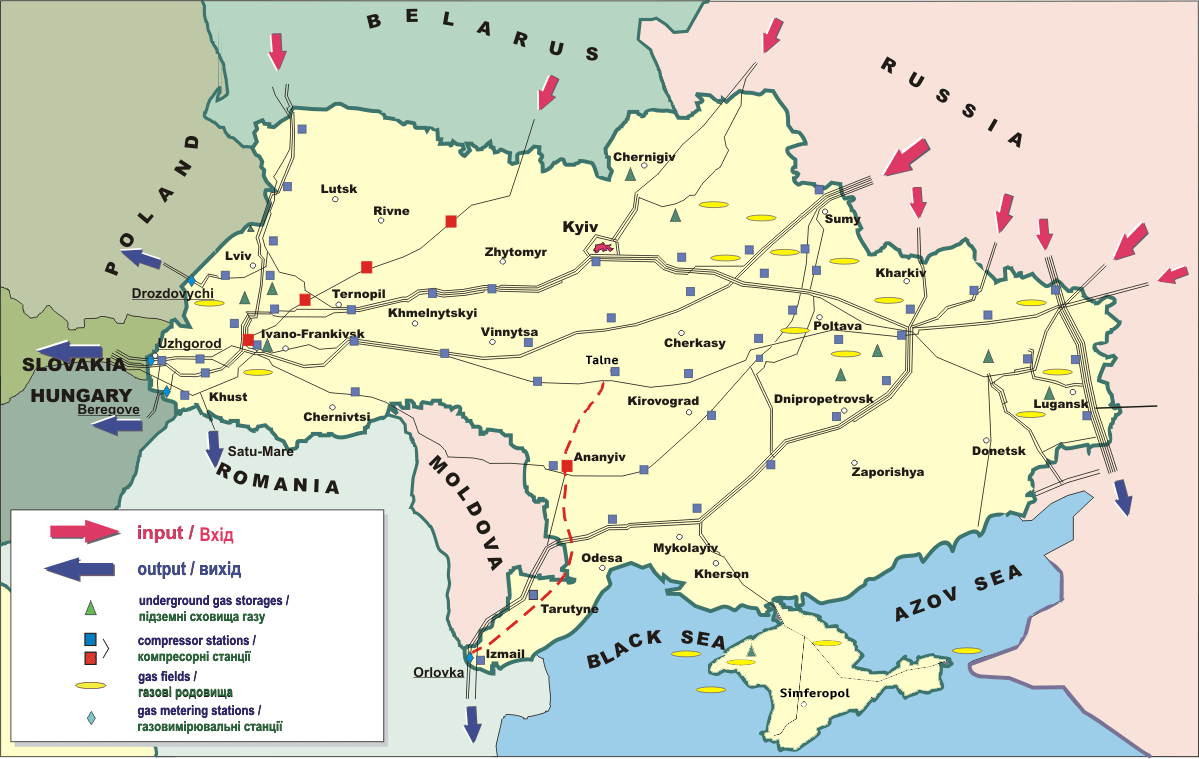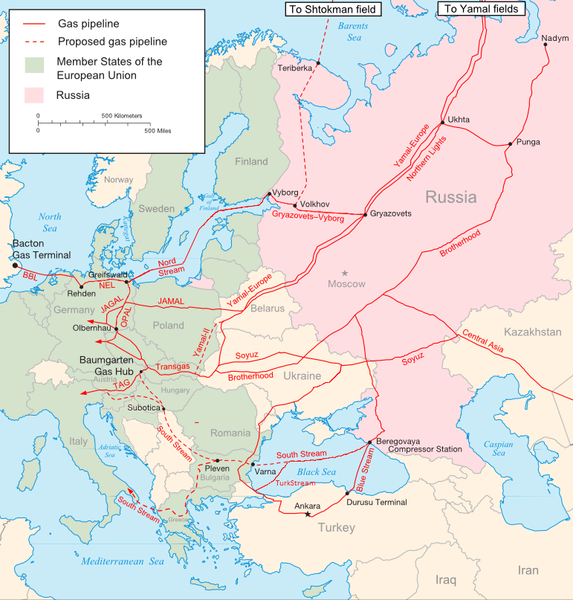The crisis in Ukraine is getting truly scary, as in US-Russia are now almost directly in conflict. Stock markets are sliding, Russia is flexing its military might with an invasion of Crimea and military “exercises” on Ukraine’s borders, while the US and other countries have condemned Russia’s actions, threatened to expel Russia from the G-8, as well as other economic sanctions.
There’s a lot more about this in the news, and I recommend reading the news with an open mind. Little-mentioned in the press is the natural-gas-fracking back-story behind this contretemps. The press is caught up in the moment-by-moment reporting of events so much that the casual reader won’t know why this is going on, and wonder whether these world leaders have gone insane.
Let’s ask this: Rather than launch yet another war over fossil fuel resources in yet another distant country, why not spend that money on developing domestic renewable energy resources?
Every time we turn on a natural gas powered appliance (stove, heater, water heater) or work in a natural gas powered factory or ride in a natural gas powered vehicle, we create demand for natural gas. The case of Ukraine demonstrates the kind of political turmoil created in remote countries so we can have natural gas. At the other end of the pipes supplying our stove with natural gas is a gas well, and that gas well may be causing nasty negative side effects to the people who live near that well.
 |
| Source: eegas.com |
This conflict over Ukraine is completely about access to natural gas supplies. Ukraine (and other Eastern European countries) have significant shale deposits that, with hydraulic fracturing (fracking), could turn into a significant natural gas resource that could free Europe from dependency on Russian natural gas. But, Russia is unlikely to let that happen without a fight.
Russian dominance over Europe
Russia has for some time had geopolitical leverage over Europe’s well-being. How? Europe doesn’t have much domestic supply of natural gas, and instead has relied on a network of natural gas pipelines to carry natural gas from Central Russia to Europe.
According to Wikipedia![]() , the European countries have varying levels of dependency on Russia’s natural gas supplies. The countries of the former Eastern Bloc have the highest dependency on Russia. Ukraine, for example, imports 66% of its natural gas from Russia.
, the European countries have varying levels of dependency on Russia’s natural gas supplies. The countries of the former Eastern Bloc have the highest dependency on Russia. Ukraine, for example, imports 66% of its natural gas from Russia.
A report by the Congressional Research Service, Europe’s Energy Security:Options and Challenges toNatural Gas Supply Diversification![]() , says Norway is the biggest natural gas supplier to Europe, closely followed by Russia. The report says a key element of the EU’s energy strategy is to shift to natural gas and as a result “natural gas consumption is projected to grow while its own domestic natural gas production continues to decline.”
, says Norway is the biggest natural gas supplier to Europe, closely followed by Russia. The report says a key element of the EU’s energy strategy is to shift to natural gas and as a result “natural gas consumption is projected to grow while its own domestic natural gas production continues to decline.”
The phrase is “Peak Natural Gas” and the effect is to put Russia in a role of dominance over Europe. History shows that it’s a bad move to let Russians have a dominant position. The report says this:
Russia has not been idle when it comes to protecting its share of the European natural gas market. Moscow, including the state-controlled company Gazprom, has attempted to stymie European-backed alternatives to pipelines it controls by proposing competing pipeline projects and attempting to co-opt European companies by offering them stakes in those and other projects. It has attempted to dissuade potential suppliers (especially those in Central Asia) from participating in European-supported plans. Moscow has also raised environmental concerns in an apparent effort to hinder other alternatives to its supplies, such as unconventional natural gas.
It also says that the U.S. has “viewed European energy security as a U.S. national interest.” Recall that the U.S. tends to be ready to go to war over national interest’s.
Promoting diversification of Europe’s natural gas supplies, especially in recent years through the development of a southern corridor of gas from the Caspian region as an alternative to Russian natural gas, has been a focal point of U.S. energy policy in Europe and Eurasia. The George W. Bush Administration viewed the issue in geopolitical terms and sharply criticized Russia for using energy supplies as a political tool to influence other countries. The Obama Administration has also called for diversification, but has refrained from openly expressing concerns about Russia’s regional energy policy, perhaps in order to avoid jeopardizing relations with Moscow. Nevertheless, although supplying natural gas to Europe from the Caspian Region and Central Asia has been a goal of multiple U.S. administrations and the EU, it is far from being achieved in volumes significant to counter Russian exports.
 |
| Source: Samuel Bailey, Wikimedia |
This is a map of the natural gas pipelines from Russia to Europe. Note how they are routed through Belarus and Ukraine. That map is a little out of date because, as I’d reported earlier, Nord Stream and South Stream are either open already or close to opening for business. Those two pipelines are being constructed to give Europe an alternate channel to access Russian natural gas than via Ukraine.
We also see in the Congressional Research Service report, that the US is supporting development of other pipelines from central Asia through Turkey and into Europe, the latter of which will bypass not only Ukraine but also Russia.
Ukraine is a risky bottleneck when Europe buys gas from Russia
Why all this effort to bypass Ukraine and Russia? It has to do with disputes over the last 10 years between Ukraine and Russia![]() .
.
Because Ukraine plays such an important role in delivering Russia’s natural gas to Europe, Ukraine has attempted to use that leverage for their own ends. The details are on the Wikipedia page, but at times Ukraine tried to increase the transit fees for shipping gas from Russia to Europe. At other times Russia accused Ukraine of siphoning off natural gas for its own needs. Ukraine has run up a large debt to Gazprom, and is otherwise economically very weak.
As a result, Russia has several times over the last 10 years cut off natural gas supply to Ukraine, and hence to the rest of Europe.
As a result of that, Europe wants to “diversify” its energy supply. For example the continent is doing a lot to develop renewable energy resources, especially over the last 10 years. But they’ve also built new pipelines, Nord Stream and South Stream, to have an alternate route through which to buy Russian natural gas.
We see some rationale for which the U.S. wants to help Europe with Energy Security. The U.S. doesn’t want Europe to be dependent on Russia, which would leave Europe vulnerable to Russian dominance.
Shale gas (and fracking) to save Europe’s collective ass?
Europe is in a risky position thanks to reliance on Russia’s natural gas. Russia tends to give with one hand while taking with two hands. We’d expect that if Russia remains the dominant supplier of gas to Europe, that over time Europe would fall deeper and deeper into Russia’s grip.
The Congressional Research Service report makes it clear that the “advent of shale gas in the United States” means the world is “potentially awash in natural gas.” The only way the world is “potentially awash in natural gas” is through fracking. It wasn’t that long ago that energy supply pundits were wringing their hands over scarce natural gas supplies. Fracking turned that around, but at a huge environmental cost.
The CRS report outlines several potential natural gas alternatives to Russia, such as Egypt and Lybia, the Caspian Sea region, and liquified natural gas imports. Coincidentally, the U.S. is preparing to increase its liquified natural gas export capacity.
 |
| Shale deposits in Ukraine, Poland, Romania, and the Baltic countries |
Recently I’ve written several reports about efforts to initiate hydraulic fracturing (fracking) operations in shale deposits in Ukraine (plus this), and Romania (plus this).
What emerged is a US State Department program, the Unconventional Gas Technical Engagement Program, whose mission is to facilitate the export of hydraulic fracturing (fracking) techniques around the world. The State Department of course isn’t doing the fracking, but is facilitating the entry of Western oil companies like Chevron into countries so that Chevron (and other companies) can set up fracking operations.
Ukraine has two large shale deposits, plus easy access to pipelines which already supply Europe with natural gas. That means Ukraine is well positioned to become rich supplying Europe with natural gas (which requires fracking the shale), while helping Europe diversify away from dependence Russia. If, that is, Ukraine remains independent enough to do all that.
Hence, it’s very important to Europe that Ukraine enter the European Union sphere of influence, rather than to remain in Russia’s sphere of influence.
Geopolitically, the U.S. is taking on the role of helping Europe reduce dependence on Russia. At the same time the U.S. is pushing Chevron (et al) as the companies to do the work of fracking the world, or in this case Ukraine.
This contretemps between the U.S. and Russia over Ukraine boils down to this: Which source of natural gas deposits will supply Europe’s needs. Which companies get the business activity in performing the fracking and natural gas mining.
In the middle is Ukraine, a country with a large population that identifies itself as Russian and hundreds of years of close ties with Russia. Because of European Union influence, Ukraine is turning towards the EU sphere of influence, but depending on events over the next few weeks Ukraine could be asunder by the U.S.-Russia tug-of-war.
- Highway design could decrease death and injury risk, if “we” chose smarter designs - March 28, 2015
- GM really did trademark “range anxiety”, only later to abandon that mark - March 25, 2015
- US Government releases new regulations on hydraulic fracturing, that some call “toothless” - March 20, 2015
- Tesla Motors magic pill to solve range anxiety doesn’t quite instill range confidence - March 19, 2015
- Update on Galena IL oil train – 21 cars involved, which were the supposedly safer CP1232 design - March 7, 2015
- Another oil bomb train – why are they shipping crude oil by train? – Symptoms of fossil fuel addiction - March 6, 2015
- Chevron relinquishes fracking in Romania, as part of broader pull-out from Eastern European fracking operations - February 22, 2015
- Answer anti- electric car articles with truth and pride – truth outshines all distortions - February 19, 2015
- Apple taking big risk on developing a car? Please, Apple, don’t go there! - February 16, 2015
- Toyota, Nissan, Honda working on Japanese fuel cell infrastructure for Japanese government - February 12, 2015




















Pingback: Europe/GAZPROM sign natural gas deal, cementing dominance by Russian fossil fuel supply | The Long Tail Pipe
Pingback: Shell Oil pulls out of Arctic Sea oil drilling, citing bad economics rather than kayaktivists | The Long Tail Pipe
Pingback: Clinton says she’d essentially ban fracking, her record on promoting fracking says otherwise | The Long Tail Pipe